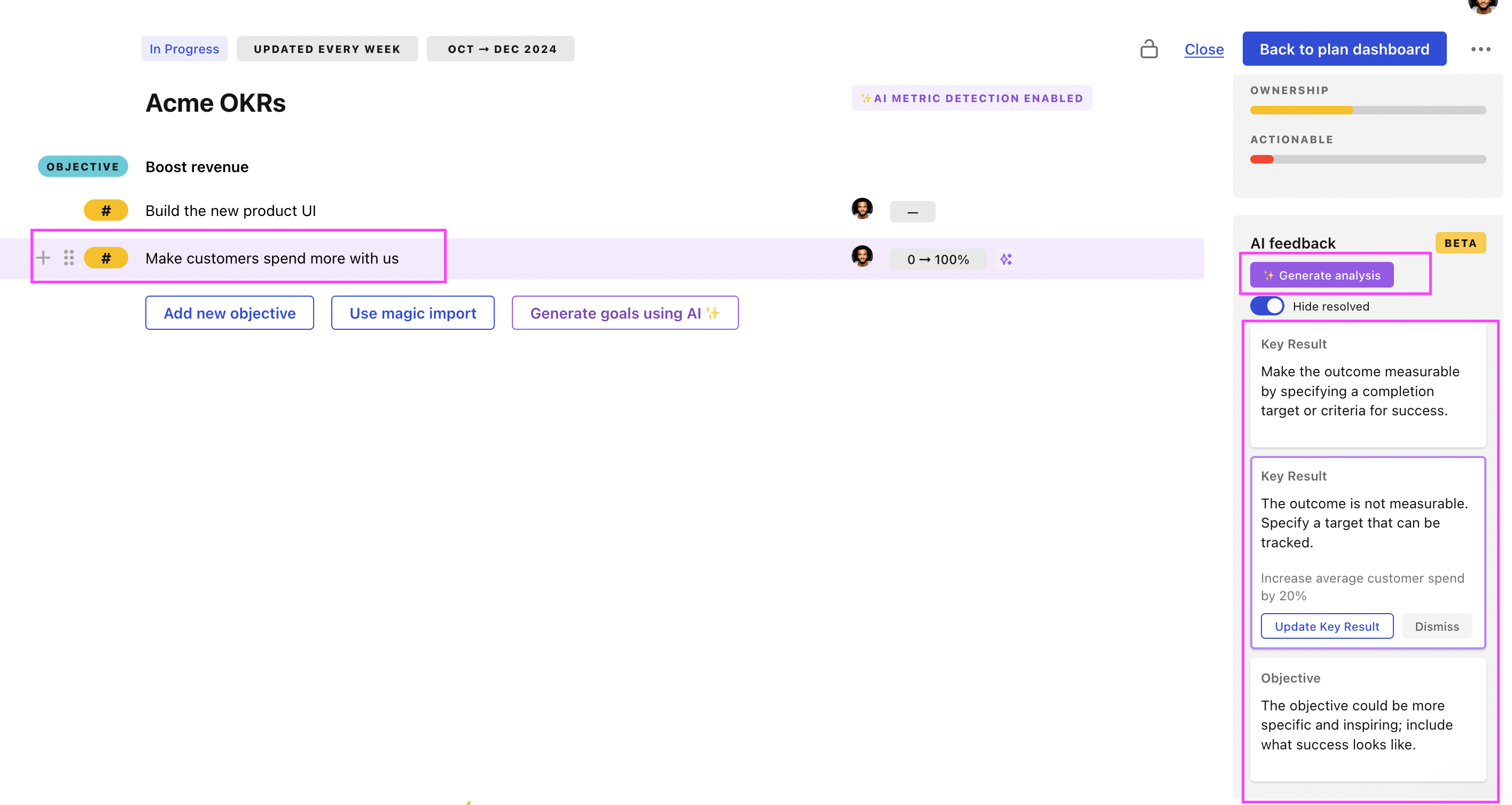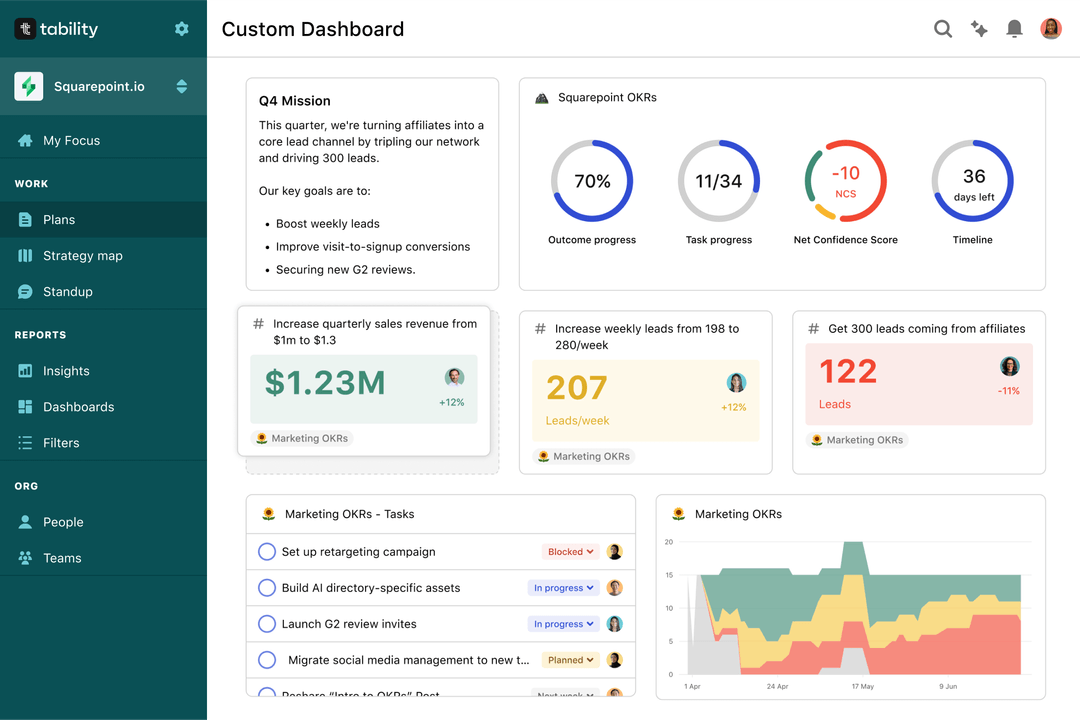Tability is a cheatcode for goal-driven teams. Set perfect OKRs with AI, stay focused on the work that matters.
What are Digital Marketing Strategy OKRs?
The Objective and Key Results (OKR) framework is a simple goal-setting methodology that was introduced at Intel by Andy Grove in the 70s. It became popular after John Doerr introduced it to Google in the 90s, and it's now used by teams of all sizes to set and track ambitious goals at scale.
OKRs are quickly gaining popularity as a goal-setting framework. But, it's not always easy to know how to write your goals, especially if it's your first time using OKRs.
We've tailored a list of OKRs examples for Digital Marketing Strategy to help you. You can look at any of the templates below to get some inspiration for your own goals.
If you want to learn more about the framework, you can read our OKR guide online.
The best tools for writing perfect Digital Marketing Strategy OKRs
Here are 2 tools that can help you draft your OKRs in no time.
Tability AI: to generate OKRs based on a prompt
Tability AI allows you to describe your goals in a prompt, and generate a fully editable OKR template in seconds.
- 1. Create a Tability account
- 2. Click on the Generate goals using AI
- 3. Describe your goals in a prompt
- 4. Get your fully editable OKR template
- 5. Publish to start tracking progress and get automated OKR dashboards
Watch the video below to see it in action 👇
Tability Feedback: to improve existing OKRs
You can use Tability's AI feedback to improve your OKRs if you already have existing goals.
- 1. Create your Tability account
- 2. Add your existing OKRs (you can import them from a spreadsheet)
- 3. Click on Generate analysis
- 4. Review the suggestions and decide to accept or dismiss them
- 5. Publish to start tracking progress and get automated OKR dashboards

Tability will scan your OKRs and offer different suggestions to improve them. This can range from a small rewrite of a statement to make it clearer to a complete rewrite of the entire OKR.
Digital Marketing Strategy OKRs examples
You'll find below a list of Objectives and Key Results templates for Digital Marketing Strategy. We also included strategic projects for each template to make it easier to understand the difference between key results and projects.
Hope you'll find this helpful!
OKRs to boost our active membership count
ObjectiveBoost our active membership count
KREnhance member benefits package to improve member retention by 20%
Launch and promote the enhanced benefits package
Analyze feedback and redesign benefits package accordingly
Survey members about desired improvements in benefits package
KRImprove digital marketing strategy to grow online engagement by 30%
Research and identify popular trends in your industry for content inspiration
Engage audience with interactive content like quizzes, polls, webinars
Implement SEO practices to improve website visibility on search engines
KRImplement a referral program to generate 50 new member sign-ups
Develop a clear, attractive referral program proposal
Launch and publicize the program among current members
Train employees to promote and manage the program
OKRs to enhance the effectiveness of our marketing strategy
ObjectiveEnhance the effectiveness of our marketing strategy
KRImprove email marketing open rates by 30%
Test various email send times for maximum visibility
Segment email list for personalized content delivery
Optimize email subject lines for relevancy and engagement
KRDrive website traffic up by 25%
Develop sponsored content or collaborations with related influential blogs
Utilize social media platforms for promotion and link sharing
Implement SEO techniques to improve site visibility in search engine results
KRIncrease social media engagement by 40%
Launch a weekly interactive quiz or contest on all platforms
Initiate collaborations with relevant influencers or brand ambassadors
Regularly post shareable, high-quality content relative to your audience
Digital Marketing Strategy OKR best practices
Generally speaking, your objectives should be ambitious yet achievable, and your key results should be measurable and time-bound (using the SMART framework can be helpful). It is also recommended to list strategic initiatives under your key results, as it'll help you avoid the common mistake of listing projects in your KRs.
Here are a couple of best practices extracted from our OKR implementation guide 👇
Tip #1: Limit the number of key results
Focus can only be achieve by limiting the number of competing priorities. It is crucial that you take the time to identify where you need to move the needle, and avoid adding business-as-usual activities to your OKRs.
We recommend having 3-4 objectives, and 3-4 key results per objective. A platform like Tability can run audits on your data to help you identify the plans that have too many goals.
Tip #2: Commit to weekly OKR check-ins
Having good goals is only half the effort. You'll get significant more value from your OKRs if you commit to a weekly check-in process.
Being able to see trends for your key results will also keep yourself honest.
Tip #3: No more than 2 yellow statuses in a row
Yes, this is another tip for goal-tracking instead of goal-setting (but you'll get plenty of OKR examples above). But, once you have your goals defined, it will be your ability to keep the right sense of urgency that will make the difference.
As a rule of thumb, it's best to avoid having more than 2 yellow/at risk statuses in a row.
Make a call on the 3rd update. You should be either back on track, or off track. This sounds harsh but it's the best way to signal risks early enough to fix things.
Save hours with automated Digital Marketing Strategy OKR dashboards

Quarterly OKRs should have weekly updates to get all the benefits from the framework. Reviewing progress periodically has several advantages:
- It brings the goals back to the top of the mind
- It will highlight poorly set OKRs
- It will surface execution risks
- It improves transparency and accountability
Spreadsheets are enough to get started. Then, once you need to scale you can use Tability to save time with automated OKR dashboards, data connectors, and actionable insights.
How to get Tability dashboards:
- 1. Create a Tability account
- 2. Use the importers to add your OKRs (works with any spreadsheet or doc)
- 3. Publish your OKR plan
That's it! Tability will instantly get access to 10+ dashboards to monitor progress, visualise trends, and identify risks early.
More Digital Marketing Strategy OKR templates
We have more templates to help you draft your team goals and OKRs.
OKRs to successfully procure and implement a smart workplace management system
OKRs to enhance Salesforce Lead Quality
OKRs to implement effective project risk management strategies
OKRs to streamline and optimize the company budget management process
OKRs to enhance account profile set up quality on eCommerce website
OKRs to enhance customer experience satisfaction